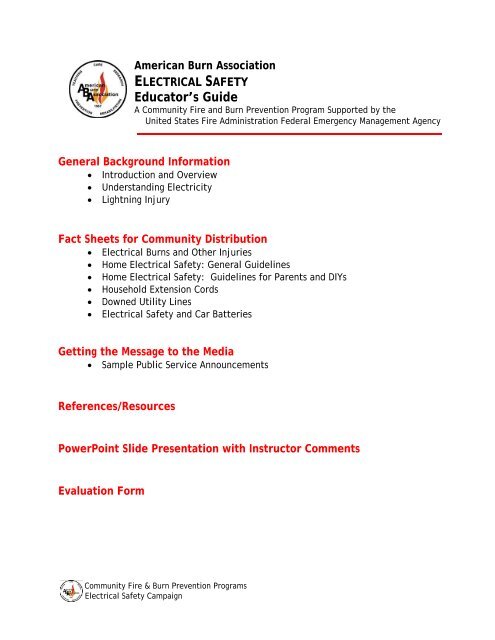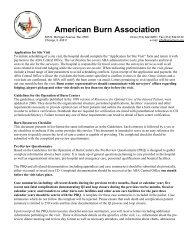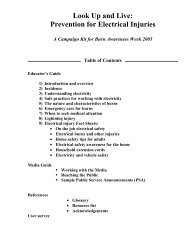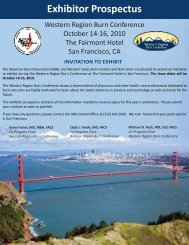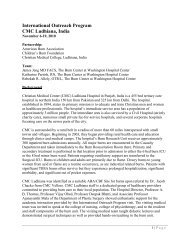Electrical Safety Educator's Guide - American Burn Association
Electrical Safety Educator's Guide - American Burn Association
Electrical Safety Educator's Guide - American Burn Association
You also want an ePaper? Increase the reach of your titles
YUMPU automatically turns print PDFs into web optimized ePapers that Google loves.
<strong>American</strong> <strong>Burn</strong> <strong>Association</strong>ELECTRICAL SAFETYEducator’s <strong>Guide</strong>A Community Fire and <strong>Burn</strong> Prevention Program Supported by theUnited States Fire Administration Federal Emergency Management AgencyGeneral Background Information• Introduction and Overview• Understanding Electricity• Lightning InjuryFact Sheets for Community Distribution• <strong>Electrical</strong> <strong>Burn</strong>s and Other Injuries• Home <strong>Electrical</strong> <strong>Safety</strong>: General <strong>Guide</strong>lines• Home <strong>Electrical</strong> <strong>Safety</strong>: <strong>Guide</strong>lines for Parents and DIYs• Household Extension Cords• Downed Utility Lines• <strong>Electrical</strong> <strong>Safety</strong> and Car BatteriesGetting the Message to the Media• Sample Public Service AnnouncementsReferences/ResourcesPowerPoint Slide Presentation with Instructor CommentsEvaluation FormCommunity Fire & <strong>Burn</strong> Prevention Programs<strong>Electrical</strong> <strong>Safety</strong> Campaign
GENERAL BACKGROUND INFORMATIONOur lives are dependent on electricity, 24 hours a day. It is such an important part of our dayto day living that it is almost impossible to fathom a world without electricity. Even while wesleep, electricity is keeping our food cold and our security systems operating. Throughout theday, throughout the year, we tend to take electricity for granted. However, as fire andemergency service workers and burn care professionals, we see the results, often devastating,when electricity escapes its insulation or is taken for granted at the wrong time and place. Theinformation in this campaign is designed to stimulate awareness of how electricity works,travels and is used, to help reduce its danger as a powerful force that can result in fire, injuryand death.In the United States, on average 400 die from electrocution and 4,400 are injured each yearbecause of electrical hazards. Of these, 180 are related to consumer products. Another 325 dieand 4,000 are injured in workplace electrical accidents, according to data published by theNational <strong>Safety</strong> Council. Electricity also causes over 140,000 fires each year, resulting in anadditional 400 deaths, 4,000 injuries and $1.6 billion in property damage. Total economiclosses due to electrical hazards are estimated to exceed $4 billion annually. 1The age distribution of electrocutions is bimodal; the first peak occurring in early childhood(below age 6) and the second in young adulthood. Most electrocution deaths in adults in adultsare work-related, and electrocution is a frequent cause of occupation-related death. 2The most severely injured victims of contact with electricity are treated in the nation’s 125specialized burn care facilities. According to the most recent (2005) report of the <strong>American</strong><strong>Burn</strong> <strong>Association</strong>’s National <strong>Burn</strong> Repository, 4.3% of the patients admitted to these facilitieshad suffered electrical burn injuries, 3 or about 1,100 patients a year. Many of these patientslose limbs or experience long-lasting damage to nerves, muscles and internal organs. Manythousand others are treated in hospital emergency departments.Lightning, a naturally occurring manifestation of electricity, is responsible for up to 100 deathsa year, according to the National Oceanic and Atmospheric Administration. With the recentexception of the year 2005, when Hurricane Katrina killed an estimated 1,200 people, lightingnormally results in the highest annual fatality total of any natural hazard in the United States.<strong>Electrical</strong> injuries are on the increase world-wide, as access to electricity increases in areaswhere less protection from its hazards may be in place than in more developed countries. Inreports from Turkey and the Dominican Republic, electrical injuries comprised a much higherproportion of burn center admissions than in the U.S.1. Data in this paragraph published by <strong>Electrical</strong> <strong>Safety</strong> Foundation International, 2006.2. “Electrocution and Life-threatening <strong>Electrical</strong> Injuries “, C. Spies and R. Trohman, Annals of Internal Medicine2006; 145:531-5373. National <strong>Burn</strong> Repository 2005 Report, <strong>American</strong> <strong>Burn</strong> <strong>Association</strong>, Chicago, ILUnderstanding electricity• Although electricity is invisible, odorless and has no shape or form, the earth’sCommunity Fire & <strong>Burn</strong> Prevention Programs<strong>Electrical</strong> <strong>Safety</strong> Campaign
atmosphere is charged with electricity. You’ll see proof of its presence in a lightningstorm. Though the electricity we use in our daily lives is manmade, it is a naturalphenomenon with absolute characteristics.• Electricity always seeks a path to the ground. All electrical contact injuries occurwhen a person accidentally becomes part of electricity’s pathway to the ground.• Electricity travels at the speed of light. It is made up of electrons that flow rapidlyin an electrical current. <strong>Electrical</strong> current moves so quickly that it can, in fact,travel the distance of the world’s circumference 7.5 times per second. Electricity isthe medium which has made possible the rapid growth of global communication.• Electricity is attracted to materials known as conductors, which allow it to flowrapidly. Some conductors include metal, water, wet objects, trees, (they containmoisture) and people (bodies contain water).• Electricity does not flow freely through certain materials used as electricalinsulation. These include rubber, glass, plastic and porcelain.• Anyone working around electricity, on the job or around the home, should always beaware of their surroundings, especially of overhead or below ground power lines.• Constant safety training and rigorous enforcement of rules for protective equipmentand safe procedures are uniformly employed by utility companies and otherorganizations whose employees routinely work around high-voltage electricity.• This document is intended mainly for educating those who may encounter highvoltage infrequently in home maintenance activities, or who care for youngchildren.• What are the major electrical hazards? Many are the result of the growing use ofelectrical power, combined with aging wiring systems that haven’t kept pace.Wiring hazards are a major cause of both electrocutions and home fires. Misuse ofsurge suppressors, power strips and extension cords is a frequent fire hazard.Contact with power lines and major appliances contribute significantly to death andinjury statistics.Lightning InjuryThunderstorms produce lightning in varying amounts. Sometimes there is just an occasionalflash or two, while at other times the storms produce lightning almost continuously, withlots of flashes to the ground. It is the flashes from the cloud to the ground (“CG flashes” forCommunity Fire & <strong>Burn</strong> Prevention Programs<strong>Electrical</strong> <strong>Safety</strong> Campaign
short) that create problems. CG flashes typically are only a small percentage of the totalflashes produced by a thunderstorm, as most lightning stays within the clouds. But it onlytakes one flash for someone to be injured or killed or for the lightning to cause a fire!Because the human body contains salty water, which conducts electricity better than air, aperson’s body may present a conduit for the lightning to reach the ground. Althoughlightning is random, there are some things you can do to minimize your risk of injury if youare caught in the open during a thunderstorm.• The time from the flash of lightning to the sound of the resulting thunder is a roughmeasure of how far away the lightning is. If you see a flash, count the seconds fromthe time of the flash to its thunder. It takes sound five seconds to move a mile.However, there is no distance from a thunderstorm that is absolutely safe. If youcan see lightning, then it is time to protect yourself from risk.CGs can occasionally jump out of a thunderstorm and strike the ground miles away,seemingly “out of the blue.” The “30-30 Rule is now advocated to address this risk.Take shelter if the time from seeing a flash until the time you hear thunder is 30seconds or less, and do not resume unprotected activities until 30 minutes haveelapsed since the last lightning and thunder• There is no “warning sign” that will reliably tell you that lightning is about to strike.Do not depend on having your hair stand on end. The first sign of a CG may be theflash itself. Of course, if your hair does stand on end, you should take steps toprotect yourself immediately! If no suitable shelter is available, observe thefollowing rules.• If you are outdoors, avoid being the tallest object around, or near the tallestobject, such as an isolated tree. Seek clumps of shrubs or trees of uniform height,ditches, trenches or the low ground. Get as low as you can, but don’t lie prone onthe ground. Go into a squat instead. Where possible, find shelter in a substantialbuilding or in a fully enclosed car, truck or van, with the windows completely shut.• At high altitudes above the tree line, seeking shelter among depressions in the rockor shallow carves will not offer much protection. Your best protection is to getdown to a lower altitude as quickly as possible. Leave your gear behind; whatever itcontains is not worth risking your life! You can always go back to retrieve it afterthe storm.• If you are in the water, get out at the first sign of lightning. If you on a small boatwithin range of land, get to land and get off the boat as soon as possible.• Avoid being near fences and power lines that lead into areas where lightning isoccurring. An electrical charge can travel along the wires and jump out at you orcause an injury if you touch live wires or an energized fence.• Avoid staying close to other people, and remain a minimum of 15 feet away ifCommunity Fire & <strong>Burn</strong> Prevention Programs<strong>Electrical</strong> <strong>Safety</strong> Campaign
possible. This will allow the current to go to ground more easily, making multipleinjuries less likely.• You do not have to be struck directly by lightning to be affected. Lightning cantravel along the ground or jump from nearby struck objects, to strike you.• If indoors, avoid water. Stay away from doors and windows. Do not use thetelephone. Take off headsets. Turn off, unplug and stay away from majorappliances, computers, power tools and TV sets. Because water may travel throughand on pipes and tubing, lightning may strike exterior electric and phone lines,inducing shocks to inside equipment.• If someone is struck by lightning, go to or call for medical help immediately! In themeantime, administer CPR to any victims if their heart and/or breathing havestopped. Cover the victims and do not move them. If they are conscious reassurethem and try to keep them calm. Seventy to 80 percent of victims survive the shockof a non-direct lightning strike. Lightning victims do not retain an electrical chargeand are safe to handle. Common lightning aftereffects include impaired eyesightand loss of hearing.Community Fire & <strong>Burn</strong> Prevention Programs<strong>Electrical</strong> <strong>Safety</strong> Campaign
ELECTRICAL SAFETY FACT SHEETSFOR COMMUNITY DISTRIBUTION• <strong>Electrical</strong> <strong>Burn</strong>s and Other Injuries• Home <strong>Electrical</strong> <strong>Safety</strong>: General <strong>Guide</strong>lines• Home <strong>Electrical</strong> <strong>Safety</strong>: <strong>Guide</strong>lines for Parents and DIYs• Household Extension Cords• Downed Utility Lines• <strong>Electrical</strong> <strong>Safety</strong> and Car BatteriesCommunity Fire & <strong>Burn</strong> Prevention Programs<strong>Electrical</strong> <strong>Safety</strong> Campaign
ELECTRICAL BURNS AND OTHER INJURIES• A severe electrical shock can cause much more damage to the body than is visible.• The most common electric shock-related injury is a burn.• <strong>Electrical</strong> burns are the result of the electric current flowing through tissues andbone. The heat generated by the current flow through the body causes tissuedamage. <strong>Electrical</strong> burns are very serious and should receive immediate medicalattention.• Arc or flash burns are caused by an electric arc or explosion, but are not trueelectrical burns, because the current does not pass through the body. They are stillserious injuries and should also receive prompt medical attention.• Contact burns may result when skin comes in contact with hot surfaces of electricalappliances or overheated electric conductors or equipment.• Clothing may be ignited in an electrical accident, resulting in a flame burn.HOME ELECTRICAL SAFETY: GENERAL GUIDELINES• Disconnect appliances by pulling on the plug, not the cord.• If an appliance has a three-prong plug, use it only in a three-slot outlet. Never forceit or remove a prong to make it fit a two-slot outlet.• Check electrical tools regularly for signs of wear. If a cord is frayed or cracked,replace it. Replace any tool if it causes even small electrical shocks, overheats,shorts out or gives off smoke or sparks.• Never use electrical appliances near water• Before attempting any appliance repair, unplug it.• Attach extension cords to appliances before outlets.• Keep clothes, curtains and other potentially combustible items at least three feetaway from all heaters, whether electric, gas or kerosene-fueled.• If an electric power line is down on or near your home, keep everyone out of thearea and call 9-1-1 or your local electric utility.Community Fire & <strong>Burn</strong> Prevention Programs<strong>Electrical</strong> <strong>Safety</strong> Campaign
HOME ELECTRICAL SAFETY: GUIDELINES FOR PARENTSAND “DIYs”IF THERE ARE SMALL CHILDREN IN YOUR HOME:• Don’t allow children to play with or near and keep them away from electrical appliancessuch as space heaters, irons and hair dryers.• Use plug covers on any electrical outlets accessible to small children. Outlet caps thatattach to the outlet plate with screws give better protection than those that plug in.• Make sure plug in caps are a similar color to the outlet.• Make sure such caps are not big enough to be a choking hazard.• Make sure any night lights used in child’s room do not resemble toys.• Teach children to respect electricity as soon as they old enough. This is usually about agethree Two thirds of electrical burn injuries occur to children aged 12 and under.IF YOU ARE PLANNING A “DO-IT-YOURSELF” PROJECT• Professional electricians can help make sure that large projects are preformed according toany electrical codes that apply to your home.• Always turn off circuit breakers and test circuits to make sure they are de-energized beforedoing any household rewiring.• When doing outside work which requires a ladder, pay attention to the location of overheadpower lines, before pruning branches, cleaning gutters, painting above the first floor level,or working on the roof.• When doing outside work that requires significant digging, such as putting in fence posts,planting trees or large bushes, or installing a sprinkler system, call your electric utility tosee if any underground lines would be affected.Community Fire & <strong>Burn</strong> Prevention Programs<strong>Electrical</strong> <strong>Safety</strong> Campaign
HOUSEHOLD EXTENSION CORDS• The U.S. Consumer Product <strong>Safety</strong> Commission estimates that about 4,700residential fires originate in extension cords each year, killing 50 people and injuring280 others.• Overheating of extension cords can occur at the plug, the socket or over the entirelength of the cord. Hot plugs and sockets are often caused by deterioratedconnections to the cord wires.• Overheating of the entire cord is usually caused by overloading (connectingappliances that need too much power for the cord’s wire size). Many older cords aremade with small wire that can overheat easily• Check the temperature of extension cords when they are in use. If they are hot tothe touch, disconnect the appliance.Community Fire & <strong>Burn</strong> Prevention Programs<strong>Electrical</strong> <strong>Safety</strong> Campaign
DOWNED UTILITY LINES• Assume that all downed utility lines are energized power lines. You may recognizetelephone or cable TV lines as such, but they may be touching damaged andenergized power lines on nearby poles.• A downed power line that appears to be dead may suddenly become re-energized asthe power company attempt to re-route power.• If you are near a downed power line, move away from the line and anything touchingit. Move away by shuffling with small steps, keeping your feet together and on theground at all times.• If you see that someone is in direct or indirect contact with a downed line, do nottouch them. Call 9-1-1 instead.• Do not attempt to move a downed line or anything in contact with it by using anotherobject such as a broom or stick. Even normally non-conductive materials like woodor cloth, if slightly wet, can conduct electricity and then electrocute you.• Be careful not to step near water where a downed power line is located.• Do not drive over downed power lines.• If you are in your car and it is in contact with the downed line, stay in your car. Warnothers to stay away from your vehicle.• If you must leave your car because of fire or other danger, JUMP away from thevehicle so that you don’t touch the vehicle and the ground at the sane time. Landwith your feet together.Community Fire & <strong>Burn</strong> Prevention Programs<strong>Electrical</strong> <strong>Safety</strong> Campaign
ELECTRICAL SAFETY AND CAR BATTERIESWhen jump-starting a vehicle, take the following precautions:• Wear safety glasses• Put out all cigarettes and other flames in the vicinity• Make sure the vehicles are not touching• Turn off the ignition of the assisting vehicle• Do not jump-start unless both vehicles are negative grounded and have the samevoltage.• When attaching battery cables:Clamp one end of first cable to positive pole of dead battery, then clamp other end to positivepole of good battery.At good battery, clamp second cable to negative jumper pole, then clamp cable’s otherend to the dead car’s engine block, on the side away from the battery.Start the car with the good battery; then start the car with the dead battery.• Detach battery cables in this order:Remove one cable from engine block and other car’s negative poleRemove other cable from positive poles.Community Fire & <strong>Burn</strong> Prevention Programs<strong>Electrical</strong> <strong>Safety</strong> Campaign
GETTING THE MESSAGE TO THE MEDIA• Sample Public Service AnnouncementsCommunity Fire & <strong>Burn</strong> Prevention Programs<strong>Electrical</strong> <strong>Safety</strong> Campaign
Sample Public Service AnnouncementsContact Name: ________________________________Organization: _________________________________Telephone: ___________________________________Email address:________________________________Subject: ELECTRICAL INJURIESRelease Date:Reading Time: 10 secondsElectricity is in every home and can injure someone you love. Call (insert localidentification) for free information on electric safety tips at (telephone number).Reading time: 20 secondsThis is <strong>Burn</strong> Awareness Month and (insert local identification) wants you to know thatelectricity can injure someone you love. Check your lamp and appliance plugs and cords tomake sure they are not loose or frayed. For free electrical safety information, call (insertlocal identification) at (telephone number.)Reading time: 30 secondsOver 4,000 <strong>American</strong>s suffer serious electrical burn injuries every year, and thousands moreare injured in fires started by electricity. Be sure your house wiring and your electriccircuits are safe and strong enough to handle the demands your appliances place on them.For free electrical burn safety and prevention tips, call (insert local identification) at(telephone number)Subject: LIGHTNING INJURIESRelease Date:Reading Time: 10 secondsUp to 100 people die each year in the U.S. from lightning strikes. Call (insert localidentification) at (insert telephone number) for free information on lightning safetyReading Time: 20 secondsSevere weather can occur with little warning. Seek shelter or stay inside as soon as you seelightning, until 30 minutes have passed from the last thunder or flash. Call (insert localidentification) at (insert telephone number) for more information on lightning andCommunity Fire & <strong>Burn</strong> Prevention Programs<strong>Electrical</strong> <strong>Safety</strong> Campaign
electrical safety.Reading Time: 30 secondsThis is <strong>Burn</strong> Awareness Week and (insert local identification) wants you to know thatlightning can kill or injure someone you love. Lightning has the highest average annualdeath toll of any natural disaster. For additional information on lightning and electricalsafety, call (local identification) at(telephone number).Community Fire & <strong>Burn</strong> Prevention Programs<strong>Electrical</strong> <strong>Safety</strong> Campaign
REFERENCES/RESOURCES AND GLOSSARY OF ELECTRICAL TERMSFounded in 1994 through a joint effort between Underwriters Laboratories Inc. (UL) the U.S.Consumer Product <strong>Safety</strong> Commission (CPSC) and the National <strong>Electrical</strong> Manufacturers<strong>Association</strong> (NEMA), the <strong>Electrical</strong> <strong>Safety</strong> Foundation International (ESFI) is NorthAmerica’s only non-profit organization dedicated exclusively to promoting electrical safetyin the home, school and workplace.ESFI sponsors National <strong>Electrical</strong> <strong>Safety</strong> Month each May, and engages in public educationcampaigns and proactive media relations to help reduce property damage, personal injuryand death due to electrical accidents. <strong>Electrical</strong> safety tips are available at the ESFIwebsite, at www.electrical-safety.org, or can be obtained by calling 703-841-3229.Other organizations with information on electrical safety include:<strong>American</strong> <strong>Burn</strong> <strong>Association</strong>www.ameriburn.orgNational Fire Protection <strong>Association</strong>(publishers of the National <strong>Electrical</strong> Code)www.nfpa.orgNational Institute for Occupational <strong>Safety</strong> and Healthwww.cdc.gov.nioshPACIFICORPPacific Power Utah Powerwww.pacificorp.comSafeKidsCanadawww.safekidscanad.caUnderwriters Laboratories(“UL Standards for <strong>Safety</strong> established the basic safety principles for America”)www.ul.comU.S. Consumer Products <strong>Safety</strong> Commissionwww.cpsc.gov/cpscpub/pubsU.S. Fire Administrationwww.usfa.fema.govCommunity Fire & <strong>Burn</strong> Prevention Programs<strong>Electrical</strong> <strong>Safety</strong> Campaign
GLOSSARY OF ELECTRICAL TERMSAmps (amperes): The standard unit for measuring electrical current flow.Breaker Box: An insulated panel on which electrical wires are mounted. Typically fuses,circuit breakers or other current-interruption devices are also included.Circuit Breaker: A device that automatically interrupts the flow of an electrical current.<strong>Electrical</strong> Load: 1) The amount of power delivered by a generator or carried by acircuit. 2) The devices to which the power is delivered.<strong>Electrical</strong> Panel: An insulated panel on which electrical sires are mountedEnergy-Isolating Device: A mechanical device that prevents the transmission or releaseof energy.Ground-Fault Circuit Interrupter (GFCI): A mechanical device to detect groundingproblems and shut electricity off to prevent a possible accident.Hazardous Energy Sources: Stored or residual energy provided by capacitors, springs,elevated machine members, rotating flywheels, hydraulic systems, and air, gas,steam, or water pressure.High Voltage: Term utilized in electrical industry referring to electrical equipment thatoperates at more than 600 Volts (for terminal to terminal operation) or more than 300Volts (for terminal to ground operation). Low voltage, high current AC or DC powersupplies are also considered to be high voltage. In the burn (medical) literature,electrical potential exceeding 1000 volts is considered to be high voltageLockout: The placement of a tag on an energy-isolating device. This prevents workersfrom operating a piece of equipment until the lock is removed.Tagout: The placement of a tag on an energy-isolating device. A tagout device is aprominent warning device of a lockout.Voltage: Electromotive force expressed in volts. If we compare electricity flowingthrough a wire to water flowing through a pipe, voltage is similar to the pressure ofthe water and amperage is similar to flow past a given point in gallons or liters perminute.Watt: A unit of electrical power, equal to the power developed in a circuit by a currentof one ampere flowing through a potential difference of one volt.Community Fire & <strong>Burn</strong> Prevention Programs<strong>Electrical</strong> <strong>Safety</strong> Campaign
EVALUATION FORMELECTRICAL INJURYWe appreciate any suggestions and recommendations for future improvements in thecommunity fire and burn prevention education programs. Please take a moment toprint and complete this form; return it to the <strong>American</strong> <strong>Burn</strong> <strong>Association</strong>, 625 N.Michigan Ave., Suite 2550, Chicago, IL 60611 (Fax – 312-642-9130). Thank you.Name (optional) _______________________________________ Date: ____________Affiliation: Hospital _______ Fire Service ___ <strong>Burn</strong> Support Organization _______Other (describe) ________________1. Did the content covered in the campaign kit meet your learning needs?Yes No2. If you answered no, please tell us what we should add, or subtract?3. Did the length of the topic coverage provide what you needed?YesNo4. Were the fact sheets helpful?YesNo5. What did you like most about this campaign?6. What did you like least about this campaign?7. What pieces of this campaign did you use? Please check all that apply.___Statistics____PSAs___Fact Sheets____PowerPoint Presentation___Press releaseCommunity Fire & <strong>Burn</strong> Prevention Programs<strong>Electrical</strong> <strong>Safety</strong> Campaign


